#Intersection 1994
Explore tagged Tumblr posts
Text

#Intersection 1994#Intersection#Richard Gere#Sharon Stone#Lolita Davidovich#Mark Rydell#Paul Guimard#Marshall Brickman#David Rayfiel#Claude Sautet#Jean Loup Dabadie#90s
3 notes
·
View notes
Text

Intersection 1994
0 notes
Photo

What do you do when they tell you that you'll never race again? You run farther than you ever have before. Our latest Atavist Magazine excerpt highlights Todd Barcelona's recovery from a traumatic brain injury.
On the afternoon that changed his life, Todd was driving home from work in his sky blue 1994 GMC Sierra truck. He had purchased it used and lowered the suspension so it sat closer to the ground. It did not have airbags.
Todd approached the intersection of Austin Peay Highway and Old Brownsville Road heading north. A Shell gas station, fields of crops, and stands of trees filled his view. The light ahead turned yellow, and he continued through the intersection. A gray Honda Accord driving south made a left at the light at the same time, failing to yield the right of way. It smashed into Todd’s truck almost head-on.
Visit Longreads to read the full excerpt.
72 notes
·
View notes
Text
Mini Lolita Fashion History Lesson: MILK
Today, MILK is generally known as an 'otome' or 'girly' brand, and many of their modern items don't look like what modern lolita think of as lolita.

A recent MILK collection However, in the late 80s and early 90s, MILK was considered to be one of the quintessential Lolita brands.

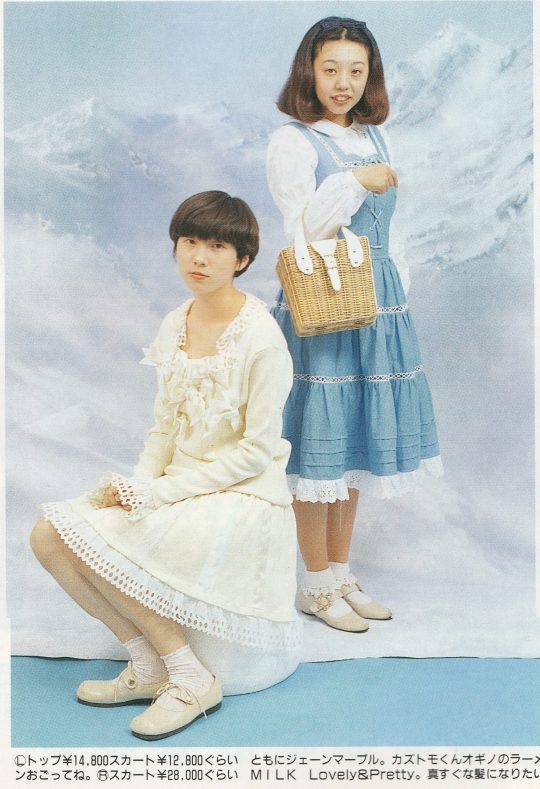
1990s lolita wearing MILK In a 1994 zipper interview about the history of lolita fashion the brand representative for MILK states "I think what is now called lolita fashion is the fashion that milk has been making for a long time."
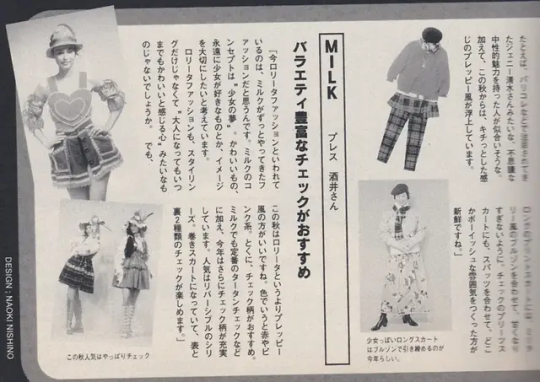
MILK was founded in 1970 by Hitomi Okawa (大川ひとみ). When Hitomi Okawa started as a designer there were not many DC brands yet and ready to wear fashion was really just starting to become more widespread in Japan. Okawa attended an art university in Kyoto because of a love of drawing that started in elementary school. She used to draw illustrations of girls and make things like paper dolls. At the age of 11, she drew many pictures of the same clothes and changed the patterns (polka dots, checks, flowers). She grew up the daughter of a doctor, in an affluent home where her mother would read magazines like Harper's Bazaar with 1950s and 1960s American fashion. She also looked at American fashion catalogs as a child, and cites this study of clothing in magazines and catalogs as her earliest sort of "studying" of fashion.
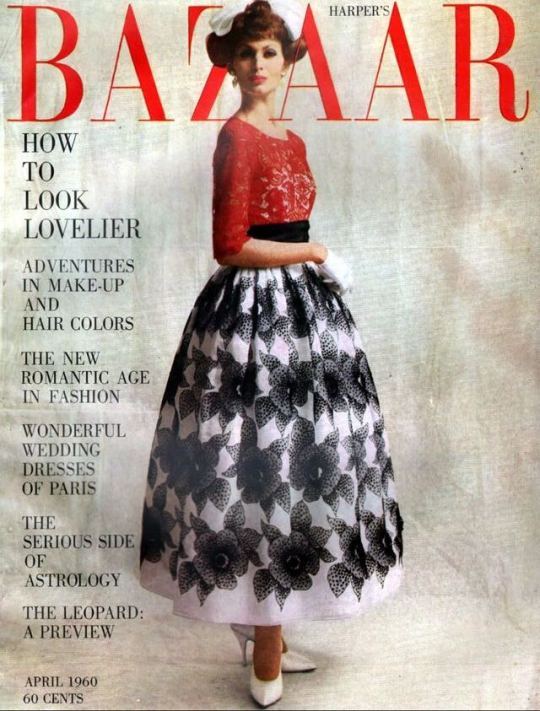

50s/60s Harper's Bazaar In addition to drawing inspiration from the 50s & 60s Harper's Bazaar & American clothing catalogs, she also drew inspiration from military uniforms and how they have custom buttons and custom fabric and details like that, as well as current trends in London and Tokyo as the brand continued to develop. When she started however, she says that she was the only one making this sort of cute girly clothing in Japan and she felt like she had to make it because no one else was making what she wanted to wear.
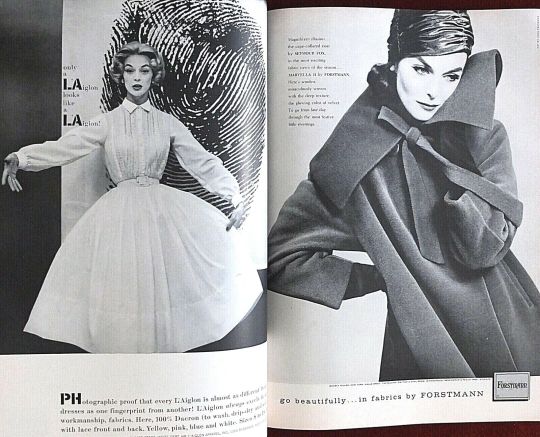
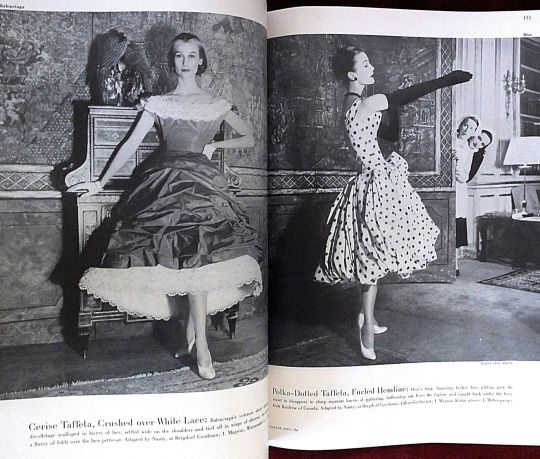
50s/60s Harper's Bazaar
After graduating from Seian College of Art and Design, Department of Design, she started MILK in Harajuku. She wanted to start in the coolest place possible, so she decided on Central Apartment.
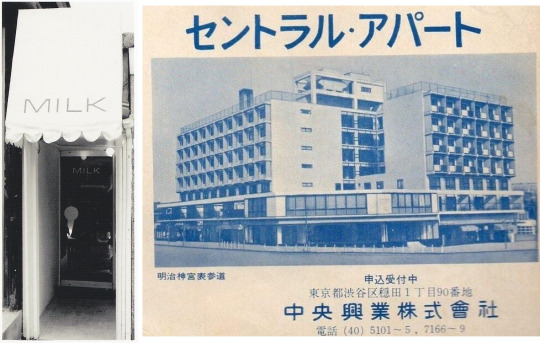
MILK Shop Front in the 70s, Central Apartment
She had come to Harajuku when she was either in High School or her first year of University and had stood in the middle of the pedestrian bridge right off Harajuku station, and she looked down at Omotesando and thought "Here is the coolest place, I want to be here!", and that's why she chose that location. The Bridge doesn't exist any more, it was torn down in 2011. She wasn't aware at the time that Central Apartment was a popular place for creators, she just thought that street was nice and that Central Apartment was modern and cool. In a 2021 interview she confessed that she sometimes still goes up to the pedestrian bridge on the Yoyogi Park side and looks at Omotesando, and when she does, she feels the same way she did when she was 20 years old.
Central Apartment (原宿セントラルアパート) was initially an apartment complex built in Harajuku in 1958 at the intersection of Meiji-dori. It was initially built for special international travelers like US military personnel. In the mid 1960s/early 1970s, the lower floors were converted into stores with offices in the upper apartment floors.
The Coffee shop Leon on the first floor was a popular spot with creative people. There were also shops like Mademoiselle Nonnon launched by designer Taro Aramaki which sold French style clothing and lots of horizontal stripes. Mademoiselle Nonnon is considered to be the source of the border (horizontal stripe) trend in Japan.

Initially, "MILK", was expensive and unrealistic for everyday wear, so it was mainly used as a stage costume for idols, however, people started wearing Milk as everyday clothing as time went on.
MILK also experimented with a Bridal line in the 70s as well.
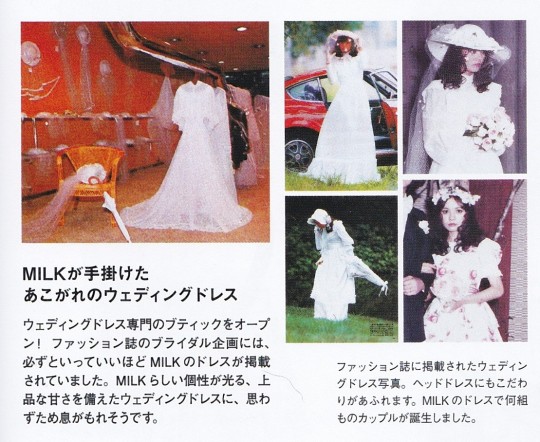
While their runway looks were generally a bit more loud than the way the pieces would have been worn in real life, you can see some prairie revival influence their early 70s items as well as some silhouettes in the '76 collection that are starting to look more lolita-esque.
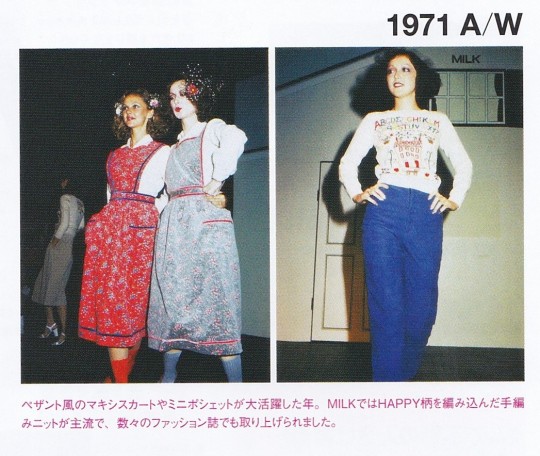
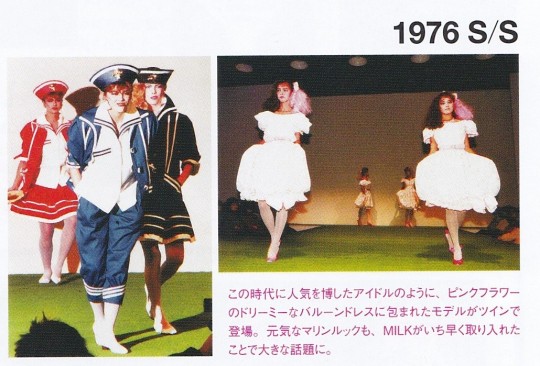
Here are a few runway examples from the 1980s, note the border print of a carousel in the 1988 collection and the knee length ruffled skirt in the 1982 one.
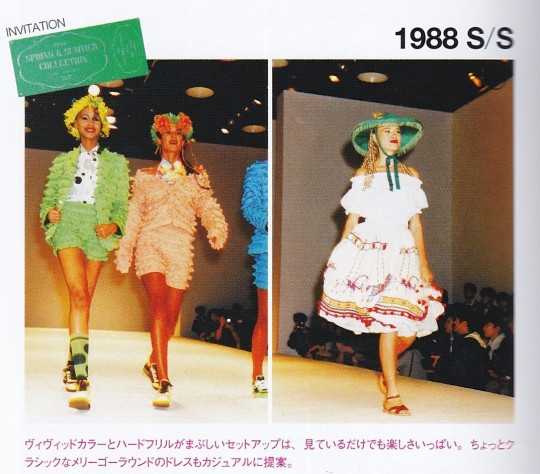
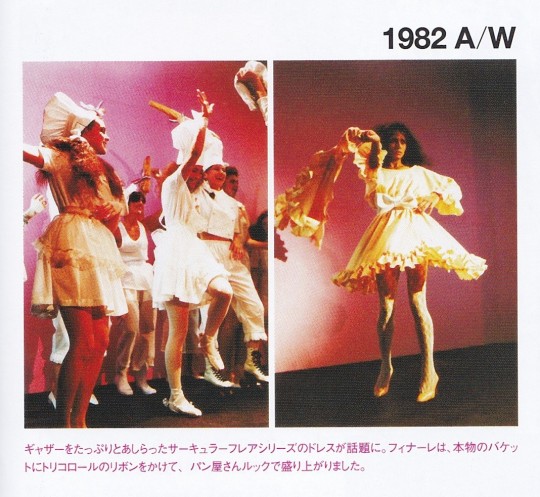
By the early 1990s, MILK was heavily featured in coordinates worn by young women who considered themselves lolita in magazines like Cutie and Zipper, and was also advertising in those magazines.
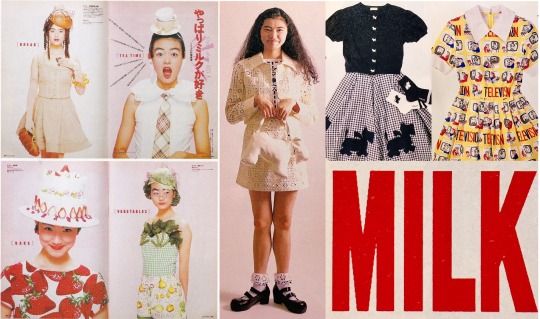
1990-1992 Cutie advertisements for MILK
Early 1990s looks from MILK were fairly consistent with what was on offer from similar shops like PRETTY and Shirley Temple.

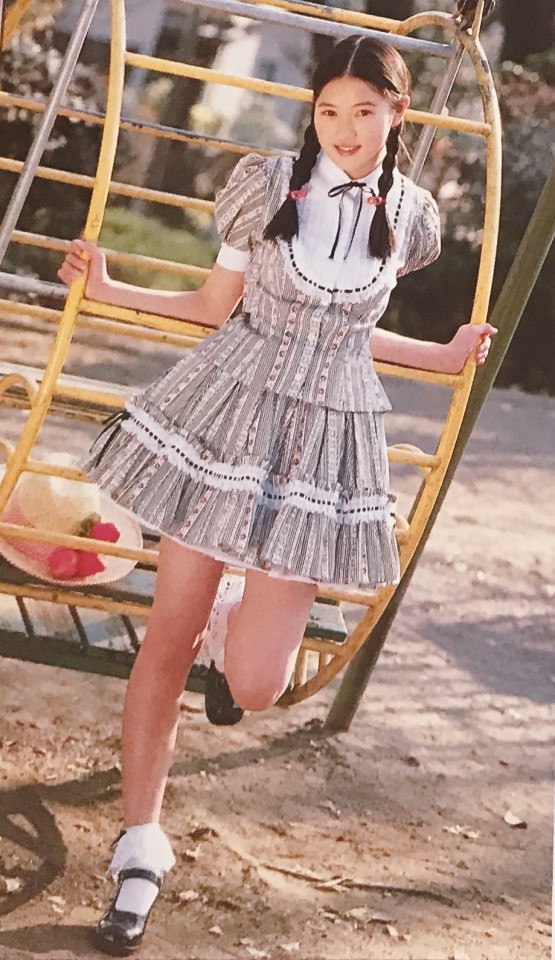
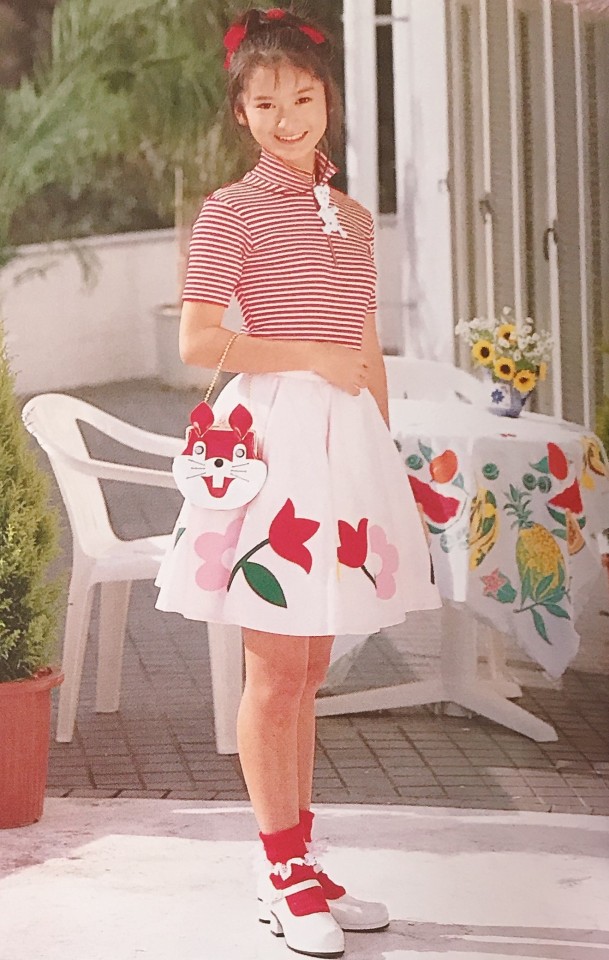


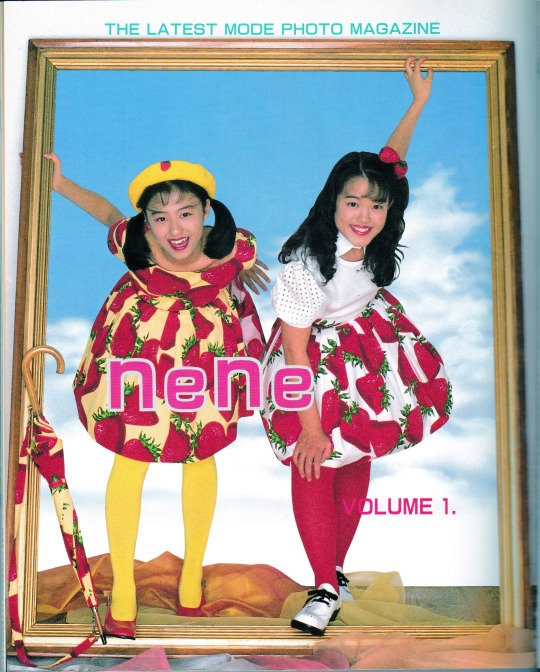
MILK Coordinates from Nene magazine, 1995
Speaking of Shirley Temple, the founder of Shirley Temple, Rei Yanagawa (柳川れい), worked as a designer for MILK before starting the Shirley Temple children's brand in 1974.
As time went on, lolita fashion started to diverge from the MILK style, while MILK followed their own design concept and look more at current trends in girly fashion. Today, some iconic MILK items like their heart purse are still frequently used in lolita fashion, however, it would be difficult to walk into MILK today and put together a coordinate that would read the same as one made from items at Angelic Pretty.
While goth and punk brands typically have no issue relating themselves to goth or punk fashion, brands popular with lolita have sometimes resisted self-describing themselves as lolita, most likely in an attempt to not alienate non lolita customers, due to lolita fashion having a mixed reputation. MILK, like many other Japanese brands, especially DC brands, maintains that they make MILK style, even though their influence on what we call lolita fashion today, is unmistakable.
Past Posts: Olive Girls
#MILK#Old School Lolita#Lolita Fashion History#Shirley Temple#90s Jfashion#80s Jfashion#70s Jfashion#Lolita History#Central Apartment#Hitomi Okawa#Mini Lolita History Lesson
344 notes
·
View notes
Text
"In these circumstances, the commercial economy of the fur trade soon yielded to industrial economies focused on mining, forestry, and fishing. The first industrial mining (for coal) began on Vancouver Island in the early 1850s, the first sizeable industrial sawmill opened a few years later, and fish canning began on the Fraser River in 1870. From these beginnings, industrial economies reached into the interstices of British Columbia, establishing work camps close to the resource, and processing centers (canneries, sawmills, concentrating mills) at points of intersection of external and local transportation systems. As the years went by, these transportation systems expanded, bringing ever more land (resources) within reach of industrial capital. Each of these developments was a local instance of David Harvey's general point that the pace of time-space compressions after 1850 accelerated capital's "massive, long-term investment in the conquest of space" (Harvey 1989, 264) and its commodifications of nature. The very soil, Marx said in another context, was becoming "part and parcel of capital" (1967, pt. 8, ch. 27).
As Marx and, subsequently, others have noted, the spatial energy of capitalism works to deterritorialize people (that is, to detach them from prior bonds between people and place) and to reterritorialize them in relation to the requirements of capital (that is, to land conceived as resources and freed from the constraints of custom and to labor detached from land). For Marx the
wholesale expropriation of the agricultural population from the soil... created for the town industries the necessary supply of a 'free' and outlawed proletariat (1967, pt. 8, ch. 27).
For Gilles Deleuze and Felix Guattari (1977) - drawing on insights from psychoanalysis - capitalism may be thought of as a desiring machine, as a sort of territorial writing machine that functions to inscribe "the flows of desire upon the surface or body of the earth" (Thomas 1994, 171-72). In Henri Lefebvre's terms, it produces space in the image of its own relations of production (1991; Smith 1990, 90). For David Harvey it entails the "restless formation and reformation of geographical landscapes," and postpones the effects of its inherent contradictions by the conquest of space-capitalism's "spatial fix" (1982, ch. 13; 1985, 150, 156). In detail, positions differ; in general, it can hardly be doubted that in British Columbia industrial capitalism introduced new relationships between people and with land and that at the interface of the native and the nonnative, these relationships created total misunderstandings and powerful new axes of power that quickly detached native people from former lands. When a Tlingit chief was asked by a reserve commissioner about the work he did, he replied
I don't know how to work at anything. My father, grandfather, and uncle just taught me how to live, and I have always done what they told me-we learned this from our fathers and grandfathers and our uncles how to do the things among ourselves and we teach our children in the same way.
Two different worlds were facing each other, and one of them was fashioning very deliberate plans for the reallocation of land and the reordering of social relations. In 1875 the premier of British Columbia argued that the way to civilize native people was to bring them into the industrial workplace, there to learn the habits of thrift, time discipline, and materialism. Schools were secondary. The workplace was held to be the crucible of cultural change and, as such, the locus of what the premier depicted as a politics of altruism intended to bring native people up to the point where they could enter society as full, participating citizens. To draw them into the workplace, they had to be separated from land. Hence, in the premier's scheme of things, the small reserve, a space that could not yield a livelihood and would eject native labor toward the industrial workplace and, hence, toward civilization. Marx would have had no illusions about what was going on: native lives, he would have said, were being detached from their own means of production (from the land and the use value of their own labor on it) and were being transformed into free (unencumbered) wage laborers dependent on the social relations of capital. The social means of production and of subsistence were being converted into capital. Capital was benefiting doubly, acquiring access to land freed by small reserves and to cheap labor detached from land.
The reorientation of land and labor away from older customary uses had happened many times before, not only in earlier settler societies, but also in the British Isles and, somewhat later, in continental Europe. There, the centuries-long struggles over enclosure had been waged between many ordinary folk who sought to protect customary use rights to land and landlords who wanted to replace custom with private property rights and market economies. In the western highlands, tenants without formal contracts (the great majority) could be evicted "at will." Their former lands came to be managed by a few sheep farmers; their intricate local land uses were replaced by sheep pasture (Hunter 1976; Hornsby 1992, ch. 2). In Windsor Forest, a practical vernacular economy that had used the forest in innumerable local ways was slowly eaten away as the law increasingly favored notions of absolute property ownership, backed them up with hangings, and left less and less space for what E.P. Thompson calls "the messy complexities of coincident use-right" (1975, 241). Such developments were approximately reproduced in British Columbia, as a regime of exclusive property rights overrode a fisher-hunter-gatherer version of, in historian Jeanette Neeson's phrase, an "economy of multiple occupations" (1984, 138; Huitema, Osborne, and Ripmeester 2002). Even the rhetoric of dispossession - about lazy, filthy, improvident people who did not know how to use land properly - often sounded remarkably similar in locations thousands of miles apart (Pratt 1992, ch. 7). There was this difference: The argument against custom, multiple occupations, and the constraints of life worlds on the rights of property and the free play of the market became, in British Columbia, not an argument between different economies and classes (as it had been in Britain) but the more polarized, and characteristically racialized juxtaposition of civilization and savagery...
Moreover, in British Columbia, capital was far more attracted to the opportunities of native land than to the surplus value of native labor. In the early years, when labor was scarce, it sought native workers, but in the longer run, with its labor needs supplied otherwise (by Chinese workers contracted through labor brokers, by itinerant white loggers or miners), it was far more interested in unfettered access to resources. A bonanza of new resources awaited capital, and if native people who had always lived amid these resources could not be shipped away, they could be-indeed, had to be-detached from them. Their labor was useful for a time, but land in the form of fish, forests, and minerals was the prize, one not to be cluttered with native-use rights. From the perspective of capital, therefore, native people had to be dispossessed of their land. Otherwise, nature could hardly be developed. An industrial primary resource economy could hardly function.
In settler colonies, as Marx knew, the availability of agricultural land could turn wage laborers back into independent producers who worked for themselves instead of for capital (they vanished, Marx said, "from the labor market, but not into the workhouse") (1967, pt. 8, ch. 33). As such, they were unavailable to capital, and resisted its incursions, the source, Marx thought, of the prosperity and vitality of colonial societies. In British Columbia, where agricultural land was severely limited, many settlers were closely implicated with capital, although the objectives of the two were different and frequently antagonistic. Without the ready alternative of pioneer farming, many of them were wage laborers dependent on employment in the industrial labor market, yet often contending with capital in bitter strikes. Some of them sought to become capitalists. In M. A. Grainger's Woodsmen of the West, a short, vivid novel set in early modern British Columbia, the central character, Carter, wrestles with this opportunity. Carter had grown up on a rock farm in Nova Scotia, worked at various jobs across the continent, and fetched up in British Columbia at a time when, for a nominal fee, the government leased standing timber to small operators. He acquired a lease in a remote fjord and there, with a few men under towering glaciers at the edge of the world economy, attacked the forest. His chances were slight, but the land was his opportunity, his labor his means, and he threw himself at the forest with the intensity of Captain Ahab in pursuit of the white whale. There were many Carters.
But other immigrants did become something like Marx's independent producers. They had found a little land on the basis of which they hoped to get by, avoid the work relations of industrial capitalism, and leave their progeny more than they had known themselves. Their stories are poignant. A Czech peasant family, forced from home for want of land, finding its way to one of the coaltowns of southeastern British Columbia, and then, having accumulated a little cash from mining, homesteading in the province's arid interior. The homestead would consume a family's work while yielding a living of sorts from intermittent sales from a dry wheat farm and a large measure of domestic self-sufficiency-a farm just sustaining a family, providing a toe-hold in a new society, and a site of adaptation to it. Or, a young woman from a brick, working-class street in Derby, England, coming to British Columbia during the depression years before World War I, finding work up the coast in a railway hotel in Prince Rupert, quitting with five dollars to her name after a manager's amorous advances, traveling east as far as five dollars would take her on the second train out of Prince Rupert, working in a small frontier hotel, and eventually marrying a French Canadian farmer. There, in a northern British Columbian valley, in a context unlike any she could have imagined as a girl, she would raise a family and become a stalwart of a diverse local society in which no one was particularly well off. Such stories are at the heart of settler colonialism (Harris 1997, ch. 8).
The lives reflected in these stories, like the productions of capital, were sustained by land. Older regimes of custom had been broken, in most cases by enclosures or other displacements in the homeland several generations before emigration. Many settlers became property owners, holders of land in fee simple, beneficiaries of a landed opportunity that, previously, had been unobtainable. But use values had not given way entirely to exchange values, nor was labor entirely detached from land. Indeed, for all the work associated with it, the pioneer farm offered a temporary haven from capital. The family would be relatively autonomous (it would exploit itself). There would be no outside boss. Cultural assumptions about land as a source of security and family-centered independence; assumptions rooted in centuries of lives lived elsewhere seemed to have found a place of fulfillment. Often this was an illusion - the valleys of British Columbia are strewn with failed pioneer farms - but even illusions drew immigrants and occupied them with the land.
In short, and in a great variety of ways, British Columbia offered modest opportunities to ordinary people of limited means, opportunities that depended, directly or indirectly, on access to land. The wage laborer in the resource camp, as much as the pioneer farmer, depended on such access, as, indirectly, did the shopkeeper who relied on their custom.
In this respect, the interests of capital and settlers converged. For both, land was the opportunity at hand, an opportunity that gave settler colonialism its energy. Measured in relation to this opportunity, native people were superfluous. Worse, they were in the way, and, by one means or another, had to be removed. Patrick Wolfe is entirely correct in saying that "settler societies were (are) premised on the elimination of native societies," which, by occupying land of their ancestors, had got in the way (1999, 2). If, here and there, their labor was useful for a time, capital and settlers usually acquired labor by other means, and in so doing, facilitated the uninhibited construction of native people as redundant and expendable. In 1840 in Oxford, Herman Merivale, then a professor of political economy and later a permanent undersecretary at the Colonial Office, had concluded as much. He thought that the interests of settlers and native people were fundamentally opposed, and that if left to their own devices, settlers would launch wars of extermination. He knew what had been going on in some colonies - "wretched details of ferocity and treachery" - and considered that what he called the amalgamation (essentially, assimilation through acculturation and miscegenation) of native people into settler society to be the only possible solution (1928, lecture xviii). Merivale's motives were partly altruistic, yet assimilation as colonial practice was another means of eliminating "native" as a social category, as well as any land rights attached to it as, everywhere, settler colonialism would tend to do.
These different elements of what might be termed the foundational complex of settler colonial power were mutually reinforcing. When, in 1859, a first large sawmill was contemplated on the west coast of Vancouver Island, its manager purchased the land from the Crown and then, arriving at the intended mill site, dispersed its native inhabitants at the point of a cannon (Sproat 1868). He then worried somewhat about the proprieties of his actions, and talked with the chief, trying to convince him that, through contact with whites, his people would be civilized and improved. The chief would have none of it, but could stop neither the loggers nor the mill. The manager and his men had debated the issue of rights, concluding (in an approximation of Locke) that the chief and his people did not occupy the land in any civilized sense, that it lay in waste for want of labor, and that if labor were not brought to such land, then the worldwide progress of colonialism, which was "changing the whole surface of the earth," would come to a halt. Moreover, and whatever the rights or wrongs, they assumed, with unabashed self-interest, that colonists would keep what they had got: "this, without discussion, we on the west coast of Vancouver Island were all prepared to do." Capital was establishing itself at the edge of a forest within reach of the world economy, and, in so doing, was employing state sanctioned property rights, physical power, and cultural discourse in the service of interest."
- Cole Harris, “How Did Colonialism Dispossess? Comments from an Edge of Empire,” Annals of the Association of American Geographers, Vol. 94, No. 1 (Mar., 2004), p. 172-174.
#settler colonialism#settler colonialism in canada#dispossession#violence of settler colonialism#land theft#canadian history#indigenous people#first nations#reading 2024#cole harris#history of british columbia#reservation system#resource extraction#british empire#canada in the british empire#homesteading#marxist theory#capitalism#capitalism in canada#immigration to canada
25 notes
·
View notes
Note
hi! I just came across your acc and read some of your posts and you seem a really inspiring individual. im a 18yo demisexual person who's really close to their queerness (both in the sexuality and gender aspects) as its a fundamental part of my individuality. and i dunno, both my being acespec and genderqueer are a tricky... thing to get into when i want to get into relationships. im trying to be happy by myself. and this was very random and all, but as you're an adult aroace (i see very very few of them) its inspiring to me knowing I can still have a good, normal life? while living in full authenticity. idk. sorry if this is random. you dont have to reply. your account was nice to come across. have a wonderful day
Thank you for this. This is why I’m here. Honestly this is most of why I came out. Seriously.
Being Different and “New”.
The world is catching up with you, so you’ll have to be patient sometimes. Language often outpaces feelings. People know how to address genderqueer (they know all the words) but they’re still learning how to process genderqueer (they’re deconstructing all the old gender “archetypes” and stereotypes they were taught by parents and teachers who didn’t address or process genderqueer in their day). They will figure it out, because they can see it’s real. But it’s frustrating, in the meantime.
Even our own community of LGBTQIA+ (in Canada we use 2SLGBTQIA+, leading with 2S for two-spirit) is catching up with us in a lot of ways. The queer community has largely thought of queer as for/about genderqueer, and so when they see aros and aces and demisexuals and demiromantics, they have to either accept or reject that there’s a whole other layer of queer called relationship queer who intersect and overlap with genderqueer inside the bigger (and for some “newly bigger”) queer category/world/thing.
Being alone.
Alone is a complicated word for us. Aspec people experience a few kinds of alone-ness. There’s completion, which allos sometimes don’t get. We’re complete inasmuch as aspec people don’t have as many spaces in their lives where they need an “other half,” even though many of us spend a lot of our lives being told we have that space and we need to fill it. I wrote about that, here.
Then there’s the way we can can feel isolated from the bigger queer world because of the ways some people refuse to accept asexuality and aromanticism as queer, because they see it as a cishet thing, somehow.
We can feel isolated from traditional communities built around faith, politics, ethnicity, national identity, or even generational identity (GenX was wiiiiildly amatonormative), all because our defining differences are falsely interpreted as “new”. People misread our orientation as a phase, or a “made up internet thing” even though we’ve always been here. For ages, the world didn’t want to talk about all the asexual, aromantic, demisexual, and demiromantic people they could see everywhere—unlabelled, but plain as day—and now that we want to talk about ourselves, they’re going to say “you’re making that up”.
Then there’s the alone-ness of trying to explain how we do love, but differently. That one’s hard. I think that’s the one I’m going through the most, this year.
“See Also”:
Anyway, here’s a poorly-sorted and always growing “library” of links to my most popular social media posts, and stuff I’ve learned as an older ace. The recurring theme is that it really is going to be okay.
I’m still me, but now I know why. (How I explain my “thing” to straight friends who knew me from before I came out.)
Phase (You don’t outgrow it. I’m proof.)
Complete (Our complex relationship with “Alone”)
1994 (The counsellor story)
When I realized (Slow origin story)
Lifeline (Something bad happened to me when I was young, and believe it or not, Spider-Man rescued me.)
Recipe for Disaster (When life happens BEFORE you figure out your orientations)
Sexual Induction rather than a sexual awakening. (Things won’t always follow the romance novel playbook.)
Complicated. (Being queer AND Christian.)
Din Djarin Aroace Rep (We love. We just mostly do all the other kinds of love)
Treasure (a note to my trans friends)
Happy Ace Week (yes we’re here)
Masked (About not being out to everyone)
Negotiating (About gaining “acceptance” from the bigger queer community.
#asexual#aromantic#aroace#aspec#asexuality#aromantic asexual#aromanticism#lgbtqia#coming out#2slgbtqia+
22 notes
·
View notes
Text

Willie M. Pickett (December 5, 1870 – April 2, 1932) was a cowboy, rodeo, Wild West show performer, and actor. In 1989, he was inducted into the ProRodeo Hall of Fame. He invented the technique of bulldogging, the skill of grabbing cattle by the horns and wrestling them to the ground
He was born in the Jenks Branch community of Williamson County, Texas. He was the second of 13 children born to Thomas Jefferson Pickett, a former enslaved person, and Mary “Janie” Gilbert. By 1888, the family had moved to Taylor, Texas.
He married Maggie Turner (1890), the formerly enslaved daughter of a white southern plantation owner. The couple had nine children.
In 1971, he was inducted into the Rodeo Hall of Fame of the National Cowboy and Western Heritage Museum. In 1989, he was inducted into the ProRodeo Hall of Fame.
Concert promoter Lu Vason founded the Bill Pickett Invitational Rodeo in 1984. The touring rodeo celebrates Black cowboys.
In 1987, a statue of him performing his signature “bulldogging” maneuver, was presented to the city of Fort Worth. The statue is installed in the Fort Worth Stockyards Historic District.
The USPS chose to include him in the Legends of the West commemorative sheet unveiled in December 1993. His family informed the Postal Service that the likeness was incorrect. Its source material was a misidentified photograph of Bill Pickett’s brother and fellow cowboy star, Ben Pickett. In October 1994, the USPS released corrected stamps based on the poster for The Bull-Dogger. In They Die by Dawn (2013) he is portrayed by Bokeem Woodbine.
In March 2015, the Taylor City Council announced that a street that leads to the rodeo arena would be renamed to honor him.
On June 2, 2017, a new statue of him was unveiled in his hometown of Taylor. It is prominently displayed at the intersection of 2nd and Main Streets downtown.
On August 6, 2018, he was inducted into the Jim Thorpe Association’s Oklahoma Sports Hall of Fame. In The Harder They Fall, his role was played by actor Edi Gathegi. #africanhistory365 #africanexcellence
7 notes
·
View notes
Text
Daily press, September 28, 1989
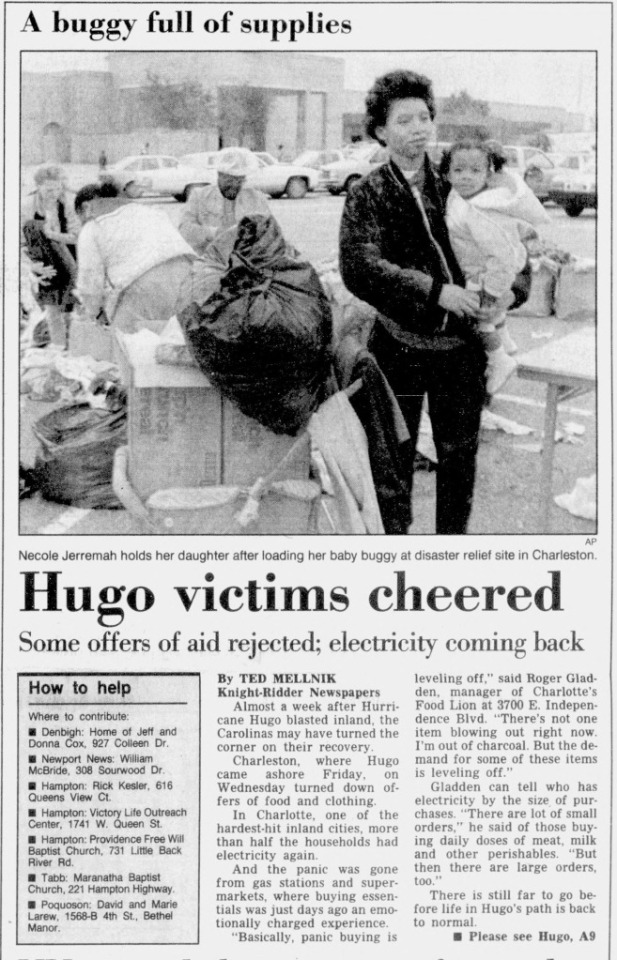
The more things change, the more they stay the same. 35 years ago people in South Carolina were still reeling from Hurricane Hugo. Very strange how people could just go to someone's house to donate (see left column) back then.
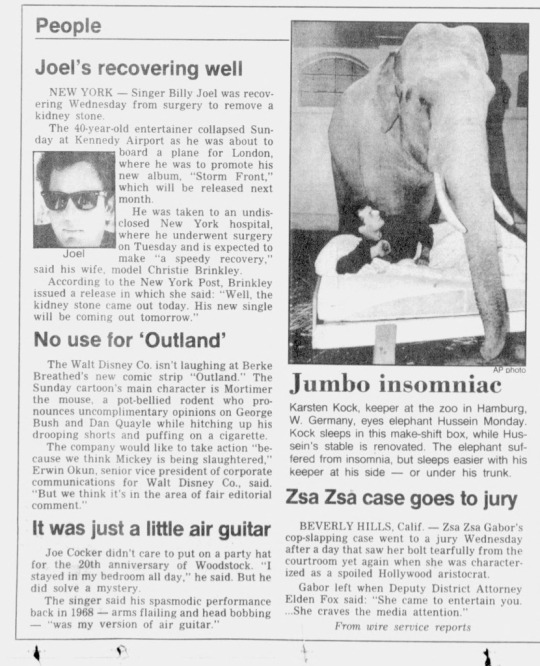
Imagine getting ready to get on a plane to London when you collapse at the airport.
I'd never heard of the comic Outland, it was a spinoff of Bloom County that ran only on Sundays. Here is Mortimer Mouse:

(eBay seller Erickson Comics and Paper)

I found this Sunday night, and then Monday night, I find out that Pete Rose died! VHS Tapes Old newspapers are magic.

Even in 1989, the clothes in these A&N ads already looked outdated. It was always like this with them. I could pull up a newspaper from 1994, and the clothes would look like the clothes people wore in ... 1989.

ooh, we have a Phar-Mor alert. We were not a Phar-Mor family, we did not visit the mythical store known as Phar-Mor. My mom said that area was too crowded. It was like a giant variety store with a pharmacy, right?
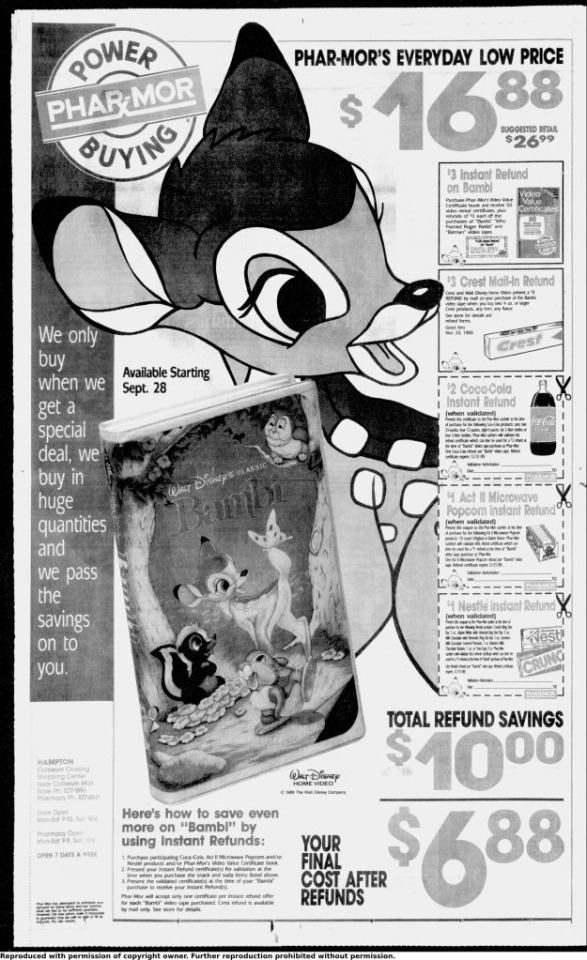

I was nosy, and looks like they broke up in 2001. So the Yorks were trying to gain "custody" of their embryo from a lab in Norfolk (they lived in California). I'm not sure if the couple were successful at having children though.

Oh no! It's our boy David Merritt! We remember him from the August 1, 1993 newspaper entry. Remember, his restaurant didn't open until 1992, and was hyping that it was going to open on April 7, 1990.
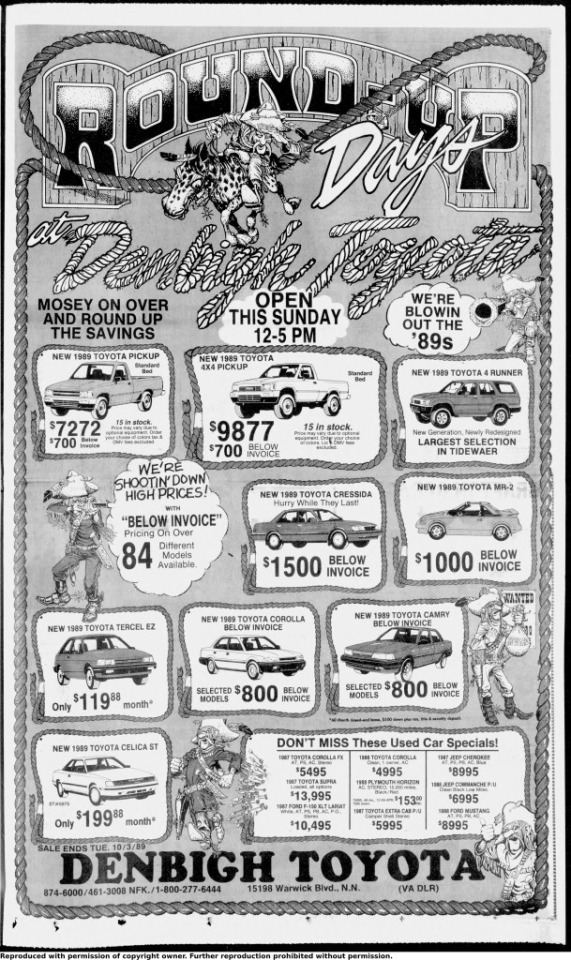

These ads are magnificent.
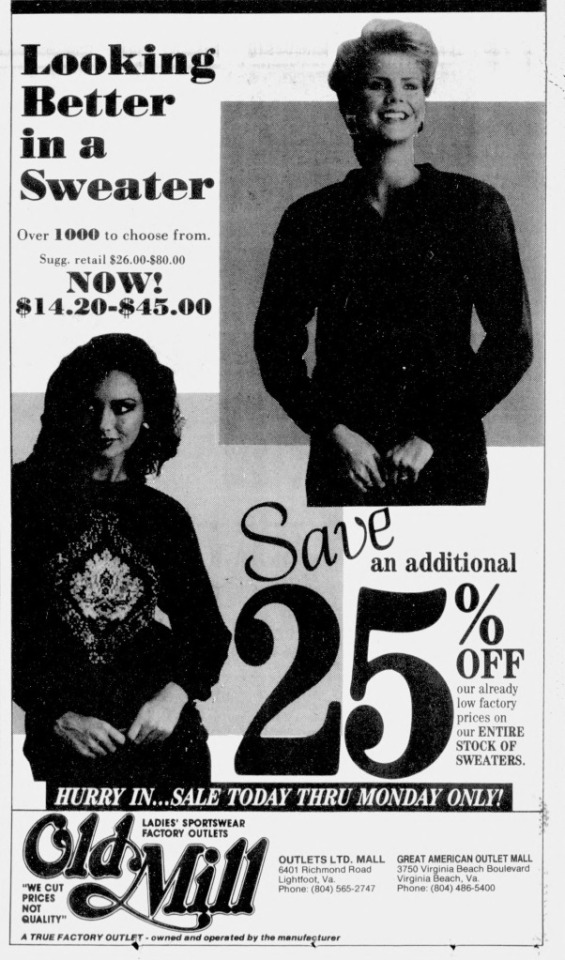
Old Mill? I gotta say it:
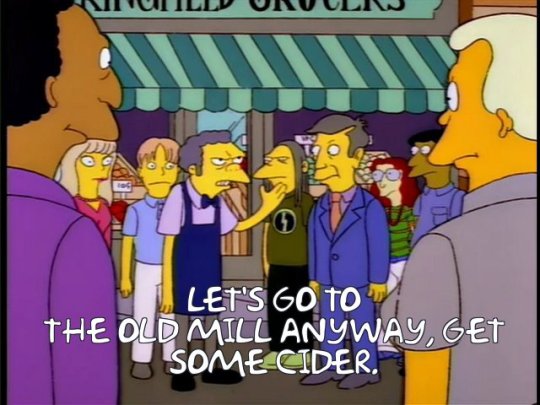
For you dead mall fans out there, both Outlets Ltd and Great American Outlet Mall are long gone.
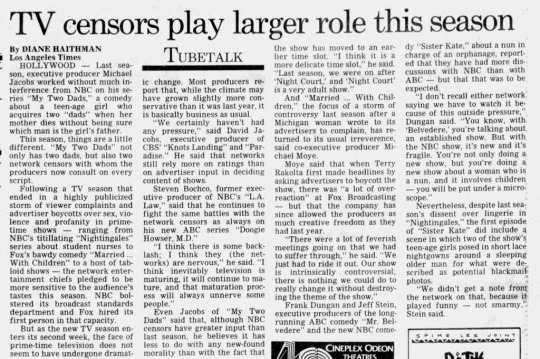
I never thought that My Two Dads needed one censor, let alone two. I gotta watch My Two Dads, it has Paul Reiser and Dana from Step by Step! I love that podcast she has with Christine Lakin about Step by Step.
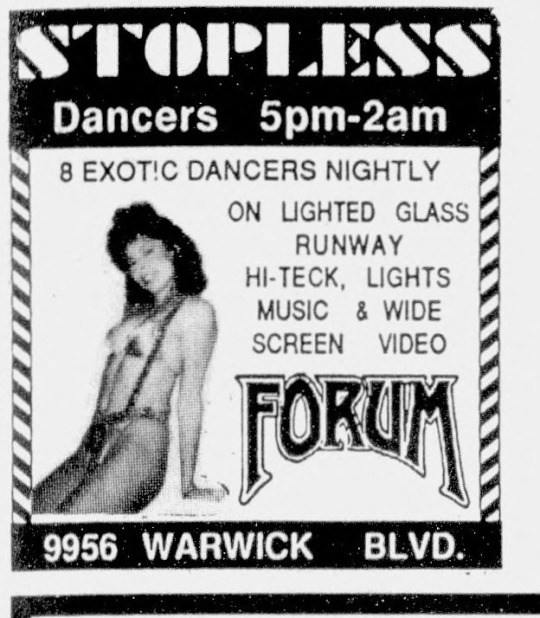
Speaking of censorship, STOPLESS GIRLS. I looked up the address, and looks like it was torn down.

No Cathy in this strip, but there are Fax jokes. Remember faxing in your lunch order? Onion rolls seem so old skool, I feel like I remember seeing them at the bakery at the grocery store when I was a real little kid, and then never again. Is it a regional thing? Do people not eat onion rolls in Hampton Roads anymore?

Garfield was upsetting that day.
OH I almost forgot. Speaking of upsetting:

A man on his bike was hit by a car down the street from the newspaper offices. So just you know, walk down the street and take a photo of it and put it on the front page of the local section. I hope Allen was ok. The McDonalds where it happened is long gone, but the building remains.
/edit/
So the day I went to publish this, I had to take the long way home from Suffolk, and I drove by this intersection on my way to the James River Bridge. Old newspapers ARE magic.

I know we make jokes about certain people putting raisins in potato salad, but what about raisins in your chicken.

I love the names of these raisin recipes! Silk Stockings?! Model T?! I would try a lil bite of each of these.

I can't remember where I mentioned this place, but it amuses me SO MUCH that back in the day you could go to Coliseum Mall and buy steaks.

wait. Bryers made jelly? I wonder if that's the same fruit that was in that yogurt they used to make that was so good. Breyers ice cream is soo bad now.

!! This was my friend Paul's mom! I about flipped when I saw this. This is exactly how five year old me remembers her. She would give me rides to school sometimes in her old jeep and would pick my mom up for room mothers.

Finally, this Eastern Airlines ad is beautiful. They had about a year and a half left, closed in 1991.
I completely forgot to post for September, I got 🦠 at the end of August that went into the first week of September, then I had to get ready for the Norfolk Zine fest, then then this weekend? Is Richmond Zine fest. Don't forget, my zines are available on my Etsy shop.

And there's a new design over at my TeePublic.
Facebook | Etsy | Retail History Blog | Twitter | YouTube Playlist | Random Post | Ko-fi donation | instagram / threads @thelastvcr | tik tok @ saleintothe90s | TeePublic Store
#1989#daily press#old newspapers#Pete rose#Phar-Mor#Hampton Virginia#hampton#newport news#raisins#zines
7 notes
·
View notes
Text
AU where tkkg is based and not borderline right wing (Set in the 70s)

It's pride month! Time to remember that the fight for queer liberation is an intersectional and anticapitalist one- the rise of the far right in Germany goes to show again, that we have to continuously fight for our rights and against all types of oppression. The fight isn't over- Stonewall was a riot ✊🏳️🌈🏳️⚧️
(Translation of the signs and explanation below, they're very specific to queer history in germany)
From top to bottom the signs read;
"Solidarity with the wildcat strikes! Gays and Migrant workers together against Police brutality"
In 1973 a big wave of strikes happened all over the country. While many workers faced repression for their actions, police brutality disproportionally affected so called "Gastarbeiters"- migrant workers who were already heavily exploited due to racical prejudice.
"rather a 'warm brother'[dated expression for gay men] than a cold Warrior"
This relates to a quote by Franz Josef Strauß, the german leader of the political party CSU (a German conservative party), who claimed to "rather be a cold warrior than a warm brother" in an interview in 1970.
"We will no longer let ourselves be oprressed! Against Paragraph 175 & 218"
While Paragraph 175, that criminalised homsexuality in Germany was finally abolished in 1994, paragraph 218 still rules abortion as a crime to this day.
#this was my first tkkg fanfic idea ever haha good times#yes I am a a queer history nerd how did you know#tkkg#karl#gaby#tim#willi#pride month#new art tag#gaby is going trough it obviously 😔#aber ich finde die Idee so interessant#70s AU
19 notes
·
View notes
Text

Born a photographer March 29, 1944. Abbas Attar was an Iranian transplanted to Paris. He dedicated himself to documenting the political and social life of societies in conflict. In a career that spanned six decades, he covered wars and revolutions in Biafra, Bangladesh, Northern Ireland, Vietnam, the Middle East, Chile, Cuba, and South Africa during apartheid. He also documented life in Mexico over several years, and pursued a lifelong interest in religion and its intersection with society.
From 1978 to 1980, Abbas photographed the revolution in Iran, to which he returned in 1997 after seventeen years of voluntary exile. His book Iran Diary 1971-2002 is a critical interpretation of Iranian history, photographed and written as a private journal.
During his years of exile Abbas traveled constantly. Between 1983 and 1986 he journeyed through Mexico, attempting to photograph a country as a novelist might write about it. The resulting exhibition and book, Return to Mexico: Journeys Beyond the Mask, helped define his photographic aesthetic.
From 1987 to 1994, he focused on the growth of Islamism throughout the world. Allah O Akbar: A Journey Through Militant Islam, the subsequent book and exhibition, spanning twenty-nine countries and four continents, attracted special attention after the 9/11 attacks by Islamic jihadists. A later book, Faces of Christianity: A Photographic Journey (2000), and touring show, explored Christianity as a political, ritual and spiritual phenomenon.
Abbas’s concern with religion led him in 2000 to begin a project on animism, in which he sought to discover why non-rational ritual had re-emerged in a world increasingly defined by science and technology. He abandoned this undertaking in 2002, on the first anniversary of 9/11, to start a new long-term project about the clash of religions, defined as a culture rather than faith, which he believed are turning into political ideologies and therefore one of the sources of the strategic struggles of the contemporary world.
From 2008 to 2010 Abbas travelled the world of Buddhism, photographing with the same skeptical eye. In 2013, he concluded a similar long-term project on Hinduism.
Most recently before his death, Abbas was working on documenting Judaism around the world.
A member of Sipa from 1971 to 1973, then of Gamma from 1974 to 1980, Abbas joined Magnum Photos in 1981 and became a member in 1985.
On Wednesday April 25, 2018 the Iranian photographer Abbas Attar known simply as Abbas, died in Paris, aged 74.
According to Abbas, in a 2017 interview with Magnum, there are two photographic methods: “One is writing with light,” he said, “and the other is drawing with light.” While he viewed other Magnum photographers like Henri Cartier-Bresson as adherents of the latter, the former was the foundation of Abbas’ practice. In lieu of placing his focus on single moments in time, he looked at his photographs as interlinked elements of a greater whole. In this sense, Abbas was a storyteller, and his images were pages of tales on celluloid, which were no less arresting when viewed (or rather, read) in isolation.
In the same interview, Abbas noted that it was a 1968 trip to New Orleans that made him understand the importance of what he called “sequencing”, or creating a narrative thread through a series of images. Examples of this can be seen in Abbas’s book Return to Mexico: Journey Beyond the Mask (1992), a document of his travels through the country in the 1980s.
His books aside, Abbas’ work has been the subject of exhibitions in galleries and museums around the world, including the Tehran Museum of Contemporary Art, the National Museum of Singapore, Galerie FNAC and the Magnum Gallery in Paris, and the Grey Art Gallery at New York University.
“It is with immense sadness that we lose him,” Dworzak said. “May the gods and angels of all the world’s major religions he photographed so passionately be there for him.”
Daily inspiration. Discover more photos at Just for Books…?
13 notes
·
View notes
Text

+++++++++++ Katharina Kaminski is a Paris based artist born in Uruguay in 1994. Kaminski works in sculptures and installations, approaching her creative practice as an exploration of the intersection between her inner and bodily self.
The body and the mystery of existence take a central place in Kaminski’s work. To develop her cosmogony, the artist uses a sculptural body language that borders on the strangeness of forms and draws from genres such as surrealism and abstraction. Kaminski sculpts and molds against the norm imposed by reason and logic, inspired only by her intuition, immersing herself in the hidden language of the subconscious. Kaminski works with ceramic, marble, and bronze, varying in scale and form: zoomorphic, amorphous, alien, meteoric. She proposes new -other- ways of looking at the biological, considering the infinite breadth of nature and highlighting interconnection between the earthly and the ethereal.
4 notes
·
View notes
Text

Intersection 1994: Sharon Stone & Richard Gere
0 notes
Text
Sunday December 15 - Happy scruff Sunday




Hello everyone, everywhere, hope your day goes as you would wish it to.
Is it Sunday already? How would I know?! Not desperately amused at the moment as it transpires that our Royal Mail service is prioritising Amazon mail/parcels over other mail. 'Other mail' being letters regarding hospital appointments et al. Don't worry about these people having to make arrangements or anything! Every bloody year they moan on about the amount of mail they have to process. "H-e-l-l-o!" Christmas happens the same time each year - have you not thought of planning for this? Oh sorry!
I post every day, usually before 10am GMT (UK time) so please join me again. Find me on AO3 for all my stories.
Here is my latest coffeebreak fluff with a Christmas feel. Hope you enjoy
Summary: Set in post-Rittenhouse times with our favourite couple together. Coffee break fluff is back! Gloriously Happy Garcy.
I'm also including a link to my Christmassy story from last year, in case you missed it
Summary: AU. Santa gives Flynn advice which he puts into effect. Some fantasy and a glorious Garcy moment
=============================================

Babylon 5 TV Series (pilot 1993 Series 1994-1998) Episode 18 Season 4 "Intersections in Real Time".
#goran visnjic#patientlibrarian fanfic#marco constante pics#crossing lines season 3#babylon 5 tv series#bruce boxleitner
5 notes
·
View notes
Text

In tribute to the memory of Rhett Forrester (September 22nd, 1956 – January 22nd, 1994) who was an American musician best known as the lead singer for New York-based band Riot from 1981 until 1984.
Rhett Forrester Background information
Born on September 22, 1956
Tucker, Georgia
Murdered on January 22, 1994 (aged 37) R.I.P.
Atlanta, Georgia
Genres: Heavy metal, hard rock
Occupation(s) Musician
Instruments:Vocals, harmonica, bass guitar
Years active: 1981–1994
Associated acts:
Riot, Jack Starr, Alex Masi Dogbone, The Black Symphony, Dr. Dirty, Dirty Water, Rachel, Hitman
Forrester was shot and killed at the Northwest Atlanta intersection of Lovejoy Street (now Centennial Lane) and Merritts Avenue, one block west of Techwood Drive (now Centennial Olympic Park Drive), after he refused to give up his vehicle in an attempted carjacking; he was only 37 years old at the time. The crime remained unsolved for some time. He was survived by his mother Lafortune Forrester, his brother, guitarist Lucky Forrester, his ex, Windi Grace, daughter, Jade Grace, and his fiance, Lori Plester, whom he was living with at the time.
One person (who apparently pulled the trigger) was killed and another was arrested for other crimes, finally admitting to being at the scene of Forrester's death, among other murders.
#metalcultbrigade#metal#artists on tumblr#art#heavy metal#hard rock#hard n heavy#classic metal#riot#riot band#rhett forrester
5 notes
·
View notes
Text
A riveting visual evolution of Oasis captured by Kevin Cummins and featuring Noel Gallagher in his own words.
How does a band come into being? What are the myriad forces that shape the sound, look, and identity of an emerging band? Oasis The Masterplan tells the story of how Oasis cemented their identity. At the center of this enterprise was Kevin Cummins, who was well aware of the intersection between the visual and the sonic and was brought on board to help the band find a look that fitted their sound. Drawing on the first six months of 1994, we follow Cummins as he photographs the band in various locations such as London, Manchester, and the Netherlands. Using many unseen images as well as more well-known iconic shots, Cummins guides us through the ways a band can be shaped and designed, such as the famous photographs of the Gallagher brothers in Manchester City shirts - emblazoned with the Brother logo (a Japanese electronics company) which helped provoke worldwide interest in the band. With input from Noel Gallagher, we see how they played with fashion, were taught how to pose, and present themselves as they approached the summer of that year when their first album, Definitely Maybe was released on August 29th. The story from that moment on is well-known and this book reveals just how effective the masterplan was to get them to that point.
5 notes
·
View notes
Note
"i know you can turn right on red in the US (you can in Germany too), but i've never heard of turning into the more distant lane of traffic on a red light" Actually I don't think this is allowed in Germany. Sometimes there is a traffic sign of a right-facing green arrow on black square ground which explicitly allows to turn right on a red light. I don't think that's allowed if no such sign is posted.
I mean yes, it's only allowed when a sign is posted, but signs are frequently posted (at least here in Berlin). Fun fact from Wikipedia:
In Germany, right turns on red are only permitted when a sign is present at the traffic light, after a complete stop. This rule was first introduced in 1978 in East Germany. It was derided as the "socialist right turn" in West Germany, which planned to eliminate it after German reunification in 1990.[45] However, a public backlash put an end to the plans, and the practice spread to the rest of Germany in 1994. Half of the 5,000 turn-on-red intersections that existed in 2002 were located in the former West Germany.[46]
Nice to know I can blame the SED for that time I got hit by a car.
16 notes
·
View notes